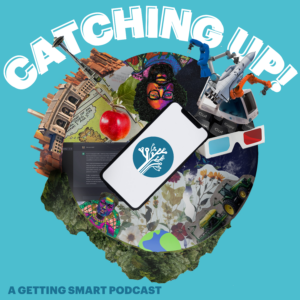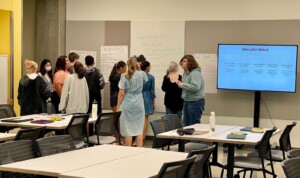Not Much New in EdTech in 2017; 3 Things Could Change That in 2018

Despite more global investment in EdTech, not much happened in 2017.
Last year the rise of artificial intelligence (as reported here) was evident everywhere–not so much in education. There were some minor advances in adaptive learning and some ad copy about AI but few new applications.
After lots of hype in fall of 2016, there were no real developments in AR/VR. A few more kids got access to Google Expeditions but no interesting new applications.
Similarly, observers were also surprised to see so little development in gaming and gamification within education this past year (despite the fact that Mary Meeker treated learning as a subset of gaming in her trends report).
Learning platforms continue to serve the schools we have not the schools we need. Most platforms support whole group learning, don’t help personalized learning, can’t make smart recommendations for what to do next, and don’t support mastery-based progressions.
More kids got online with Chromebooks in 2017 (a trend that started in 2012, peaked in 2016) and, now that most schools have pretty good computer access, most kids benefited from more formative assessment but we can’t combine formative assessment from different sources.
Without student loan deals, US EdTech investment in 2017 was about the same as last year but fewer deals are getting done. Funding rounds are getting bigger, fewer and later. It’s harder to raise that first seed round. And, after your Series A (the first priced round) you better have proven market fit and a business model to piece together a B round.
It may have been quiet in the US, but it was a big year in China. Over a quarter of EduVC investments were made in China last year–and mostly monster rounds going to tutoring and test prep companies. Three of the four EdTech IPOs last year were Chinese companies.
After almost a decade of venture investment, it’s clear that EdTech is quite different than consumer internet. Few products go viral and freemium business models (free stuff with the hope that you’ll upgrade to a premium version) doesn’t produce sustainable businesses. With few exits, investors are more risk averse than five years ago.
In K-12, it’s not the tool that is the innovation, it’s the learning experiences that teacher teams create with new tools. For most youth, learning is motivated in relationship and grows in community. Thinking about innovation as a powerful sequence of youth development experiences is very different than designing the next EdApp.
Where is the Innovation?
While not much new happened in EdTech in 2017, there are pockets of K-12 innovation fueled by three drivers: adoption of broader aims, efforts to personalize learning and the (long awaited) platform revolution in education.
Broader aims. Given exponential change in the #FutureofWork, a growing number of schools, districts and networks are adopting new student learning goals. Some describe it as an updated profile of a graduate.
Most schools are paying more attention to social and emotional learning (SEL). The Aspen Institute’s National Commission on Social-Emotional and Academic Development has advanced the conversation and will provide additional resources this year. Leading SEL advocate CASEL will expand its city and state partnerships (check out this podcast with CASEL chair Tim Shriver).
Given the interest in growth mindsets, SEL and career readiness, a growing number of schools are engaging students in project-based learning and all of its more open-ended maker and inquiry-based cousins.
Personalized learning. Most schools have made a commitment to personalized learning which powered a few years of strong Chromebook sales and elementary adoption of adaptive learning tools (DreamBox, i-Ready).
Most promising are new school models sponsored by XQ, NGLC funds, and NewSchools Venture Fund. These bundle broader aims, new tools, and powerful learning experiences.
Platform plays. Seven years ago (when I wrote Getting Smart) I thought the publishers, in their conversion to digital learning, would make big investments in platform strategies but that didn’t happen. Instead, platform leadership has emerged in three areas:
- Free app ecosystems: After sharing free productivity tools, Google and Microsoft released lightweight learning platforms (both called Classroom) that quickly became widely adopted in K-12. The good news is that schools have access to simple free tools. The bad news is that the free app ecosystems have been a big damper on platform investment and innovation.
- Private equity roll-ups: Vista Equity Partners bought Powerschools from Pearson in 2015 and started bolting on acquisitions including Haiku, Chalkable, SunGard, and others to create an integrated solution. [1/19 note: see release on PowerSchool-Microsoft partnership.] Frontline, an aggressive HR roll up, was acquired by Thoma Bravo in August. Both have the scale and appetite to invest in platform innovations.
- Networks: CZI made a big investment in Summit Learning and extended access to 330 teacher teams. New Tech Network updated Echo for its 200 project-based schools. The combination of networked learning models and tools is likely to be a continued source of innovation. Renewed network investment by the Gates Foundation will help spur innovation in platform networks.
Artificial intelligence is creeping in around the edges of learning platforms. There are a few adaptive platforms (RealizeIt and Fishtree) and a few more making use of some machine learning. But few are supporting competency-based learning. Apparently vendors have not seen strong enough market signals that the world is shifting from keeping time to show what you know.
Needs More Attention
Two issues could use more attention from public private partnerships–a barrier and an opportunity.
Improving interoperability. A new iNACOL report calls for better performance assessments and more assessment literacy–from the classroom to the state capital. To boost calibration (consistent standards-referenced feedback), the report encourages more cross scoring between districts to build capacity and accuracy.
A complementary approach to providing more and better feedback to students is to improve the inability to combine formative feedback from multiple sources. The good news is that many fifth graders in America get five forms of feedback in math every week (e.g., teacher scored worksheet, end of unit quiz, DreamBox score, Khan Academy badge, MAP score) but it remains difficult to combine these into a synthetic view of progress. It’s a psychometric and technical problem, but also it’s a business model problem. It will take pressure and incentives to get vendors to move away from owning item level detail as core IP.
Better interoperability is fundamental to progress on competency-based education where student progress (in most districts and networks) will be guided by judgements made based on multiple assessments.
Signs of aggregated demand like the districts and networks joining Project Unicorn are a good start. IMS Global and Ed-Fi could make joint progress on combining formative assessment in 2018.
Comparability studies of learner profiles of students in different learning models will inform interoperability initiatives.
AI + Blockchain. You’ll continue to see more artificial intelligence showing up in learning platforms, digital assistants, adaptive math and reading apps, writing feedback systems, assistive technology, student scheduling, and transportation planning.
Platform networks (groups of schools that use a common learning model, tools, and professional learning) are the best vehicle for investing in AI projects.
The transformational technology of the next decade will be blockchain, a distributed record of transactions creating a trust network that enabling peer to peer value transactions. It’s still pregame warmups for blockchain applications in learning but it looks like it will be an integral part of the shift to personalized and competency-based learning.
Blockchain will end paper based certificates, automate the award, recognition and transfer of credits, increase learner ownership and control over their own data. In a few years, portable learner profiles could utilize blockchain technology.
Blockchain has improved the transcript conversation, but there are many things can be done with today’s tech if we had better interoperability and some agreements on how to describe and measure human capabilities. Blockchain will enable a great distributed public database but human judgements about what’s important will remain a central challenge. (Read about efforts to build a common mastery transcript to better describe graduate capabilities.)
Eventually it will be AI-powered platforms and blockchain profiles and transcripts that power personalized learning–but that’s a few years out. It will be piloted in platform networks as the result of public private partnerships.
Not much new happened in EdTech in 2017 but teacher teams continued to develop new learning environments that included incremental innovations to better serve all students.
For more see:
- 15 Predictions for the New Year
- Ask About AI: The Future of Learning and Work
- Building a Shared Vision of the #FutureofLearning
Stay in-the-know with all things EdTech and innovations in learning by signing up to receive the weekly Smart Update. This post includes mentions of a Getting Smart partner. For a full list of partners, affiliate organizations and all other disclosures please see our Partner page.







Daniel
"The good news is that many fifth graders in America get five forms of feedback in math every week (e.g., teacher scored worksheet, end of unit quiz, DreamBox score, Khan Academy badge, MAP score) ..." five forms! for fifth grades! each week! I not sure those are good news...